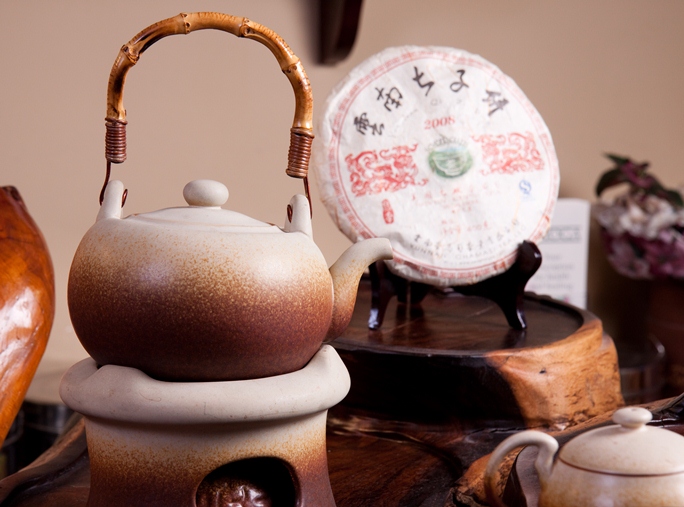
The History and Value of Pu-er

The History and Value of Pu-er
With a culture boasting 4,000 years of history, the Chinese tea has lately been heralded as an investment item in the recent two decades. "Cantonese people are particularly fond of pu-er, as we believe in its power of inhibiting greasiness and inducing peace of mind, which make the tea a favourite at yum cha sessions," said Chan Kwok-yee, a well-known Chinese tea specialist. "The public's curiosity of pu-er tea has also been piqued by the soaring price – from a few hundred Hong Kong dollars per cake between the 1930s and 1940s to a few hundred thousand Hong Kong dollars per cake nowadays, making it a collection item of splendid value." And to understand the tea's value, knowledge on the types of pu-er is key.
Pu-er is generally categorised as 'raw' and 'ripened'. The raw pu-er is the result of stir-frying freshly plucked tealeaves in a wok to rid them of grassiness, before the leaves are dried and turned into 'maocha'. The raw pu-er leaves are then pressed into cakes, bricks or processed as loose leaves to be matured – ridding its grassiness again in 10 years and wildness in 20 years, and fully fermented in 30 years – to produce top-notch pu-er tea with a rounded finesse.
Ripened pu-er is usually dried maocha piled three feet high, with 30 catties of water poured onto every 100 catties of ripened pu-er tea, before it is wrapped in a gunny sack to let the tea humidify, oxidise and ferment. The tea is turned and piled every two to three weeks to ensure even fermentation. When fermentation is complete in about two months, the tea will be stored in a dry barn until it can be sold in a year's time. "The pu-er tea we drink at the Chinese tea restaurants is usually ripened pu-er, while the high-quality pu-er pursued as an investment item is usually raw pu-er," said Chan.
"From the time it is made into maocha, raw pu-er can appreciate in value by 15% to 20% every year, 50% by its third year of maturation, and one fold by the fourth and fifth, which is why raw pu-er is known for its high collection value," said Chan. "Quality pu-er plucked from tall trees high up in the mountains can cost HKD300 to HKD400 per cake before maturation, and HKD3,000 to HKD4,000 if matured. That is why we in the tea industry like to say it's wiser to have pu-er saved up than saving money in the bank!"
Apart from its enhanced finesse and resultant drinking experience from maturation, pu-er is also known as a low-risk collection item as the maintenance of its perfect form only requires dry storage from sunlight and rain.
Putting on the Kettle
To beginners daunted by the myriad of ways of Chinese tea appreciation, Chan offered his advice: "The rarity of a tea is never a concern for true tea lovers. With the right brewing method, a tea can still exude its full flavour after seven brews."
The main difference between raw and ripened tea is that raw tea usually induces a pleasant mouthfeel, and sweet aftertaste that is absent in the ripened tea. "The desired mouthfeel varies," added Chan. "Tea cakes and bricks are characterised by a rounded finesse because of the pectin produced in the process of steaming and pressing. Loose leaves, on the other hand, have a refreshing taste because they are not steamed to softness."
When it comes to making quality judgement by colour, tea is not unlike wine. "A good cup of tea is highly translucent as it means the tealeaves are clean and uncontaminated – tealeaves plucked from higher terrain would produce tea that is crystal clear. Raw tea in its first year has the jade green like green tea, before it turns into light yellow (like fried rice) in its fifth year, deep amber in its 10th year, reddish-orange in its 20th year, maroon in its 30th year, and brown in its 40th." The maturation duration of ripened tea tends to be less easily distinguishable as it is dark brown from the first year onwards.
When brewing your tea, it is important to 'cleanse' the tealeaves twice with 100oC water and brew it with 98oc water for 10 seconds before pouring it into the cup for the first and second brews. For the brews afterwards, be sure to leave 20 seconds for the third brew, one minute for the fourth brew, three minutes for the fifth brew, five minutes for the sixth brew, and 10 minutes for the seventh brew.
All You Need to Know about Tea Appreciation
Pu-er is widely known for its power to inhibit greasiness. While raw pu-er is particularly helpful in promoting the loss of fat and preventing high cholesterol, high blood sugar, and high blood pressure, ripened pu-er is believed to help warm the stomach and rid the body of bloatedness.
"With declined stomach functions, it is wise for senior citizens to avoid raw tea – as its 'cold' nature makes it a stimulant to the stomach – and opt for 20-year (or over) ripened pu-er instead. People with respiratory problems, poor sleep quality, less perspiration, and who are often in and out of air-conditioned rooms may want to try the ripened pu-er-and-rhodiola mix easily available on the market, as it helps to warm the stomach and moisten the body." Note also that tea consumption an hour before and after meal is not recommended for the protection of the digestive system.
There is a plethora of ways to learn to appreciate tea, such as self-taught and seeking advice from teahouses. Meanwhile, it's also a good idea to try the free tea tasting offered at some tea houses, where you can meet like-minded tea lovers over a nice cuppa.
Special Thanks:
Chan Kwok-yee, Chairman of The Best Tea House Co. Ltd.
www.besttea.com.hk